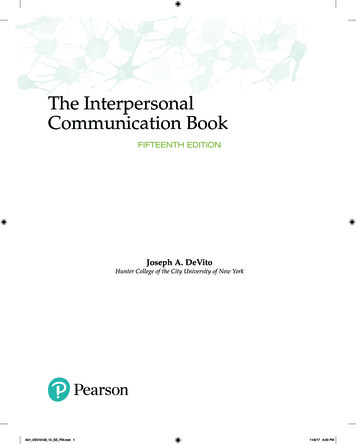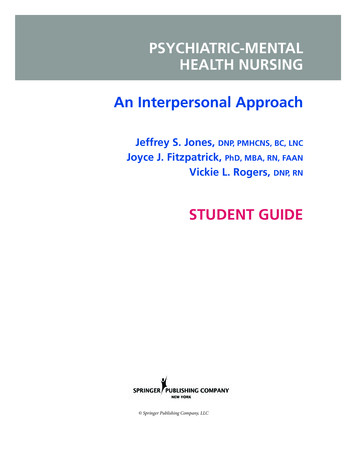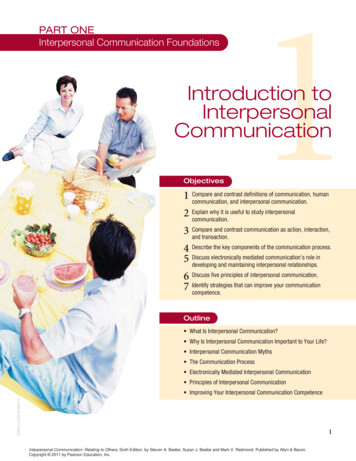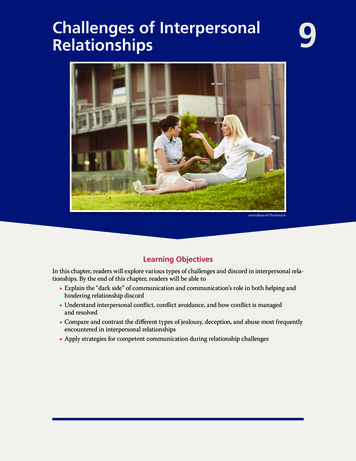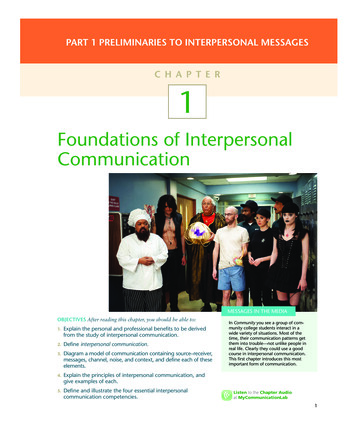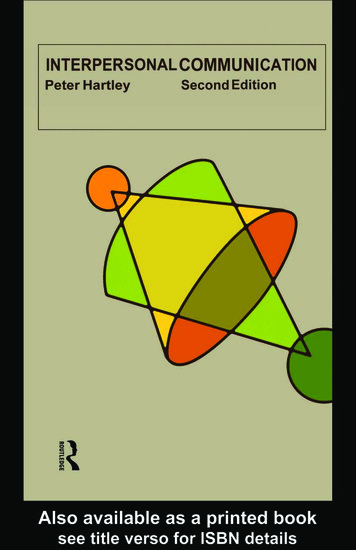
Transcription
InterpersonalCommunicationHow do people communicate with each other in their face-to-face meetingsand conversations? Can we trust our first impressions of people, or shouldwe be more cautious? What evidence is there that our gestures and facialexpressions reveal to others what we ‘really’ mean?Interpersonal Communication provides a framework for understandinghow we communicate with others in everyday situations. Peter Hartleyexplores the key features of the skills we use in communicating with otherpeople, and provides a comprehensive introduction to the hows and whysof interpersonal communication.This expanded and revised second edition outlines the main components and distinctive characteristics ofinterpersonal communication offers detailed analysis of communication processes, considering theireveryday applications and implications includes new material on contemporary issues in communication studiessuch as race and gender explains the debate over differences between male and femalecommunication looks to the future of the subject, introducing new areas such ascomputer-mediated communicationPeter Hartley is Senior Academic in Communication Studies at the Schoolof Cultural Studies, Sheffield Hallam University.
InterpersonalCommunicationSecond editionPeter HartleyLondon and New York
First published 1993Second edition first published 1999by Routledge11 New Fetter Lane, London EC4P 4EESimultaneously published in the USA and Canadaby Routledge29 West 35th Street, New York, NY 10001This edition published in the Taylor & Francis e-Library, 2001. 1993, 1999 Peter HartleyAll rights reserved. No part of this book may be reprinted or reproduced orutilised in any form or by any electronic, mechanical, or other means, nowknown or hereafter invented, including photocopying and recording, or in anyinformation storage or retrieval system, without permission in writing from thepublishers.British Library Cataloguing in Publication DataA catalogue record for this book is available from the British LibraryLibrary of Congress Cataloging in Publication DataHartley, Peter, 1946–Interpersonal communication / Peter Hartley – 2nd edn.Includes bibliographical references and index.1. Interpersonal communication. I. Title.BF637.C45H35 199998–47600153.6–dc21 CIPISBN 0–415–20793–2 (hbk)ISBN 0–415–18107–0 (pbk)ISBN 0-203-01971-7 Master e-book ISBNISBN 0-203-17393-7 (Glassbook Format)
ContentsList of ECTION AUnderstanding interpersonalcommunication151 Defining what we mean by interpersonalcommunication162 The process of interpersonal communication283 The skills of interpersonal communication424 Communication skills in context62SECTION BThe components of interpersonalcommunication775 The social context786 Social identity96
VIDEFINING WHAT WE MEAN7 Social perception1108 Codes 1: codes and language1259 Using codes 2: incorporating the non-verbals142SECTION CIssues and controversies in interpersonalcommunication16110 How useful are ‘popular’ models of interpersonalcommunication?16211 Do men and women communicate differently?18112 Does assertiveness work?193SECTION DGoing beyond interpersonalcommunication20313 Communication and groups20414 Final thoughts: is computer-mediated communication(CMC) a new form of interpersonal communication?221NotesIndex230247
.210.312.1Linear model of communicationHartley’s model of interpersonal communicationArgyle’s social skills modelHargie’s revised model of social skillsThe Johari windowComponents of the social contextRole diagramPositions round a coffee house tableComplementary transactionCrossed transactionTypical eye positions according to NLPStyles of 19.110.1Different forms of communicationEarly language developmentHall’s model of personal distanceCharacteristics of the ego states20131152172
A c k n o w l e d g e m e n tsThanks to many colleagues who helped me get the first edition off theground, especially to Guy Fielding, Gary Radford, Andrew Beck and JaneWeston.Thanks to the colleagues who gave me support, ideas and inspirationfor this second edition, especially to Mark Neath, Caroline Dryden andJonathan Grove.Special thanks to Kathy Doherty who produced the original outline andresearch for Chapter 11 and then helped to develop it.Thanks to all the students whose interest and questioning helped medevelop my ideas.Thanks to Chris Cudmore and Rebecca Barden at Routledge for theirsupport and patience.And special thanks to my primary group – Julia, James and David – fortheir perseverance while I huddled over and, more recently, talked to theword processor.
IntroductionIf you have picked up this book to flick through the contents, then Iprobably do not need to convince you that face-to-face communicationbetween people is an important part of everyday life. Our relationships atwork, home and at play are critical to our psychological well-being. Mytelephone company is also convinced of this – it quotes a recent surveywhich ‘showed that 60% of the British public would like to be better atcommunicating with their friends and family’.1 Of course, you might not besurprised that a communications company wishes to promote the fact that‘it’s good to talk’, but we can find plenty of evidence from other sources tosupport its views on the value of communication.The way we communicate also influences our life opportunities insituations such as job or course interviews. The importance of interactiveor interpersonal skills at work is frequently emphasised and this has led toa corresponding increase in training, seminars, workshops and publicationswhich focus on these skills, across a very wide range of organisations. One
2INTRODUCTIONBritish example is the ‘Good Practice Guide to Officer Safety’ published bythe London Metropolitan Police in 1995, which includes recommendationson the body posture which should be used in different situations. It advisesofficers to respect cultural differences and ‘mirror’ certain body signalswhen talking to people from different ethnic groups. You will find similaradvice in the manuals and handbooks issued by many commercial andservice organisations.We cannot change our interpersonal behaviour just by reading a book.So what is the value of a textbook like this, apart from helping some studentsget through their course assignments? Can a book like this make anydifference to your everyday situation? Before I try to answer that lastquestion, I’ll spell out the main aims of this book.The main aim is to provide a basic introductory text on interpersonalcommunication, i.e. face-to-face communication between two people. So Ihave tried to: explain the special or distinctive characteristics of interpersonalcommunication identify the component parts of interpersonal communication explain how these components relate to one another explain the most important features of the skills we use when wecommunicate with other people contrast the characteristics of interpersonal communication with otherforms of communicationAll of these aims are directly relevant to our everyday situations becausewe cannot just rely on specific behaviours or techniques to communicateeffectively – we need to understand the process and adjust what we do tosuit the context. And this is not as easy as it sounds.You may have been invited to seminars or workshops which claim togive you ‘simple tips on the power of eye contact with strategies that workfor even the largest audiences’ or show you the ‘special body positions touse in dealing with specific kinds of difficult people’.2 Or perhaps you haveseen the correspondence course which will give you ‘everything you needto quickly and enjoyably acquire mastery of speaking and writing skills inthe shortest possible time’.3 And what about those books in your localbookseller which claim to ‘change your life’ or help you to ‘read the (bodylanguage) signals and find love, wealth and happiness’?4
INTRODUCTION3There is plenty of advice on how to communicate ‘better’, but is thisadvice based upon sound principles? Is the advice always consistent?Can you apply it in every situation? For example, can you believe theauthor who promises to explain ‘the simple but powerful piece of bodylanguage which virtually guarantees that your audience will remember thekey part of your message, weeks and months later, without having to takea written note’?5 What do you believe and what do you act upon?As you may have gathered from the tone of the last few paragraphs, Iam sceptical of many of these claims. This book is based upon the idea thatyou must try to understand the process of communication as well as theway people behave. And there are a wide range of social and culturalfactors which can change both the process and the behaviours when wecommunicate. After reading this book, I hope you will have a much clearerpicture of the richness and complexities of human communication, and willhave a few ideas which you can apply to your own behaviours and feelings.In the rest of this introduction, I will explain how this book is organised.But first I will give a few examples which introduce major themes of thebook: the importance of understanding how we communicate the dangers of oversimplified analysis the impact of specific behaviours and techniquesHow can understanding interpersonalcommunication help?In one sense, we all spend a lot of time working on this already. When wasthe last time you talked to work colleagues or college friends about ‘whyperson X said that’? Or when you talked with your partner about yourrelationship with the neighbours, or why the kids do not seem to be talkingto you as openly as they used to? If we are involved in everydaycommunication which seems to be ‘going wrong’ then we try to work outwhy. This book will hopefully give you ideas which approach these problemsfrom a fresh angle. Consider the following conversation between A and Band then decide who they might be:A:B:‘What’s the matter?’‘Nothing.’
4A:B:A:B:INTRODUCTION‘What’s the matter?’ (said with increased volume and more emphasis on the word matter)‘Nothing!’ (said slower and with increased emphasis)‘OK!’‘OK!’ (One or both people then leave the room)Remember who you thought A and B were? We’ll return to that in a minute.I have shown this extract to many people. They have all been able torecognise it from their own experience, often in several different contexts:parent/child communication; communicating with a work colleague;communicating with a fellow student; communicating with a flatmate orpartner; and communicating with a husband/wife/partner. To take the parentexample, I have experienced this conversation from both sides, as childand as parent. If you are a parent and you have just had a conversation likethat with your son or daughter, how do you feel about it? What are yougoing to do next? What has this conversation done to your familyrelationships? Do you feel that you have done everything you can sensiblydo as a parent? Or do you feel that you have failed as a parent in thatencounter and go away feeling depressed that you have not got to the rootof the problem?You can reflect upon and analyse that conversation from a number ofdifferent angles which are presented in this book. For example, one analysiswould suggest that, if this is a regular conversation in the family, the parentand child have played a ‘game’ (using concepts I discuss in Chapter 10).This game is designed to satisfy their subconscious feelings about theirrelationship without having to take any more positive action about it. Bothparties can feel that they have acted ‘as they should’. But this disguisesthe fact that there may be underlying problems in the relationship, whichremain unsolved.This analysis is one of several possibilities. Another way of examiningthe conversation would be to look at the non-verbal communicationbetween A and B. For example, have you assumed that the conversationwas serious? Could it be a game in the more usual sense of having fun? AreA and B indulging in verbal play, using the Simpsons as role models?Assuming it is serious, you could also investigate the way A describestheir relationship with B and vice versa; and investigate how A and B seetheir respective roles; and so on. But this begs the important question –
INTRODUCTION5how do we decide which method is the most appropriate? And there isanother complication – all of these methods could give misleading resultswithout more detailed background knowledge of the situation. For example,what was your visual image of A and B? Were they partners, or parent/child or what? Were they both white or black or of different ethnicbackground? Were they both middle class, working class or from differentclass backgrounds? You would have to consider all these possibledifferences before arriving at a sensible analysis of the situation.So the most sensible strategy must be to use various forms of analysisand consider a range of possibilities. This book will give you a range toselect from.Can understanding interpersonalcommunication save your life?A well-known American security consultant, Gavin De Becker, suggeststhat many victims of personal violence fail to recognise the warning signalswhich would enable them to withdraw from a dangerous situation beforethey become trapped.6 He argues that attackers typically use certaincommunication strategies to gain the confidence of their victims. They canthen lure them into a situation where the attack can take place with the leastchance of being noticed or interrupted. These strategies are all designed tocommunicate trust and innocence. A couple of examples will illustrate thepoint.One of the strategies is what De Becker calls ‘forced teaming’, where theattacker tries to establish a relationship with the victim by suggesting thatthey are both in the same boat. Supposing you are waiting to catch a bus,late at night, in a lonely bus depot, where there are few people around. Astranger approaches you and says: ‘So your bus is late as well. You justcan’t trust these timetables nowadays.’ Is this an innocent comment topass the time of day? Or is the stranger deliberately trying to establish arelationship with you by showing that he is in the same boat as you?Another strategy is what De Becker calls an excess of ‘charm andniceness’. Again, this could be perfectly innocent but may also be deliberatestrategy. De Becker’s third strategy is what he calls ‘too many details’. Thestranger in the bus depot may start to tell you a very interesting story
6INTRODUCTIONabout why he is visiting the city, or why he must catch that bus, or aboutthe unfortunate experiences he has had trying to catch buses late at night.All of these strategies can lull you (the victim) into a false sense ofsecurity. On their own, each of these strategies may of course be perfectlyinnocent. When they are used deliberately by a prospective attacker, andwhen they are used in combination, then they can signal that the situationis not as innocent as it may seem. De Becker notes that many victims dohave an uneasy feeling, an intuitive danger signal, about their attacker.These intuitive warnings are often because the strategy used by the attackerseems slightly false or unnatural.De Becker’s thesis is that people can learn to analyse the communicationthey receive, recognise danger signals and withdraw or seek help before itis too late. His book is based upon his organisation’s fairly extensiveexperience of dealing with risk. It is also interesting to note that it is endorsedby a wide range of commentators, ranging from lawyers and prosecutors,to representatives of bodies who are involved in work with victims, suchas the American Domestic Violence Council, through to celebrities such asMeryl Streep and Carrie Fisher. The book offers considerable anecdotalevidence, both of the strategies used by attackers and the recommendedavoidance strategies.I also found some anecdotal evidence to support his views in one of myrecent lectures. After I had used one of De Becker’s accounts to illustratehis list of strategies, I noticed that one of my female students seemedparticularly interested. After the lecture, she told me that she had experiencedalmost exactly the same conversation while she was waiting for a flightconnection in an American airport quite late at night. Before she had achance to accept the offer of help from the stranger who approached her, apolice officer intervened to warn her that the stranger had a record ofviolent crime.But De Becker’s book does not offer systematic research data and hedoes not explicitly investigate all the different examples of potential danger.Perhaps there are some factors which are more important in certain situations.Can we simply accept his views without more evidence from differentsources? All his examples are American – do the same principles apply inother cultures?
INTRODUCTION7What should we believe aboutinterpersonal communication?We all have a set of beliefs about social life and about our society. Thesebeliefs may be based on quite flimsy evidence. For example, would youaccept the following propositions about modern society? nowadays families tend to eat more snacks modern families no longer sit down for family meals in the way that theyused to this decline in family meals is ‘symptomatic of a wider breakdown infamily structure and values’Of these three propositions, we have ample evidence from the foodmanufacturers and retailers to support the first. The second and third doseem to have been accepted by some sociologists and journalists – but onwhat evidence? Recent work by Anne Murcott suggests that reality in theUK is/was more complicated.7 The stereotypical family meal which fosteredcommunication and harmony may have been a middle-class ideal whichwas not always the norm. Interesting though this is, the main point for thisbook is that we may have ‘false’ beliefs which not only shape the way wesee the world around us but also influence our behaviour. How manyparents have pressurised their children to eat round the table on theunderstanding that this was both the norm and would promote familyharmony?A more specific example of how our beliefs affect how we communicateis the way many managers act as if communication were ‘one way’ and‘linear’ and ignore any other possibilities. This is discussed in more detailin Chapter 1 when we look at models of communication.What do the media tell us aboutinterpersonal communication?Talking about our beliefs about society inevitably raises questions of mediainfluence. We have all probably seen at least one TV chat show whichprobed into the communication and relationships between two or three‘ordinary’ members of the public. Many American chat shows now seem tothrive on difficulties in relationships by allowing the participants to bare
8INTRODUCTIONtheir souls and feelings to millions of viewers. As I took a break from wordprocessing this chapter, I noticed Jerry Springer talking on his own TVshow to John about his best friend, Marcia, who was sitting beside him.Marcia then revealed that she was harbouring a secret crush on John.Springer then developed the conversation by asking how John felt aboutit, and then brought in his current girl friend to see how she reacted to thisrevelation (of course, I have changed these names to ensure anonymity!).The audience was now focused on John, absorbing his every movement.Does his averted gaze mean good or bad news for Marcia? Naturally, theseexchanges are always sensitively handled without any consideration forthe ratings advantage that a sensational confession might bring!Some critics argue that TV has become almost obsessed by these conflictsand tensions in everyday relationships, perhaps because they make forrather cheap programming which nonetheless attracts large audiences.The latest variants on this obsession are the programmes which ‘eavesdrop’on everyday interaction. Recent examples on British TV include the seriesof programmes looking at battles between neighbours, and the variousprogrammes looking at people in their everyday jobs and activities such asworking in a hotel or taking driving tests. The unwitting stars of theseprogrammes can go on to become minor celebrities in their own right.Another variant uses hidden cameras to spy on real tourists who are forcedto confront situations which test the validity of the popular nationalstereotypes. What will we learn from discovering whether the Germantourists will share the sun-beds?It is not just television which seems to have become increasinglyinterested in people’s everyday relationships. There are numerous examplesof this fascination in the newspapers. One major British daily newspaperreassures me that ‘body language is the key’ to success at my next jobinterview and so ‘improving your body language is vital’. The Saturdayissue of this same paper always includes a column which analyses aphotograph of celebrities in terms of what their body language is reallytelling us.8As well as observation and analysis, we can also find plenty of adviceon how to improve our communication and relationships. Every day (or atleast it seems like every day) I can find feature articles which explain how tocreate/mend/improve my relationships with others. The newspaper agonyaunt continues to thrive, usually concentrating on sexual problems but
INTRODUCTION9also offering many more comments to do with repairing relationships. Andthis is often augmented by more general advice on how to behave. Forexample, the Saturday edition of the Daily Mail includes a column by aDrusilla Beyfuss who is described as ‘Britain’s premier etiquette expert’.She also responds to readers’ questions and ‘guides us through the mazeof modern manners’. Recent examples have included how to use first-nameterms in the workplace, how to decline loan requests, and analysing whetherit is ‘bad form’ to prop up your juicy invitations on the mantelpiece.9The flood of advice is also promoted by media ‘crossover’ where onechannel works to promote and feed off another: TV chat shows interviewauthors; newspapers often use new books to create feature articles; andso on. Two recent examples from the British press will illustrate. An articlein the ‘career’ section of one daily newspaper started with the observationthat ‘touching your colleagues could ease your path to the top at work’.This then developed into a series of quotes and thoughts from Alan Pease,the Australian author and trainer who has delivered widely advertisedseminars and also written on body language. The article simply quotedPease’s views without any hint of analysis or criticism.10Another British daily described one recent American best-seller as ‘aDIY therapy guide that tells you all about yourself’. The article explainedthat the book has been ‘touted as the world’s cheapest therapy’, claimingthat it can combine all the secret revelations you can obtain from a personaldiary with the sort of advice you will get from a good therapist.11Throughout the book you are invited to fill in the blanks on a series ofquestions. These start with fairly innocuous personal details but thenmove quickly on to fairly deep revelations about a person’s history, includingfor example the moment you are most ashamed of and the last time youcried uncontrollably. Not only does this book invite you to spill out yoursecrets on to the printed page, but the author also suggests that the answersshould be shared with friends or even the new neighbours. He also suggeststhat couples embarking on a long-term relationship should swap their copiesof the book before becoming too committed.Why worry about media portrayals ofinterpersonal communication?There are several serious difficulties with much of this media advice:
10INTRODUCTION it offers very simple ‘slogans’ which are supposed to apply to everyoneregardless of cultural or social background it often ignores individual differences in behaviour it offers ‘quick-fix’ solutions to communication problems, again usuallyignoring the social contextUnfortunately, these concerns are not new. While researching for thisedition, I came across a paper by Judith Hall Koivumaki, in which sheanalysed five accounts of body language from the most popular bestselling books in the USA in the early 1970s.12 She made some very powerfulcriticisms, including:findings are often over-simplified, hypotheses and truisms are stated asfacts, and the reader is often in the dark as to whose research is beingreported.These books encourage, quite literally, the exploitation of one personby another.My reading of popular books over the last few years suggests that thesecriticisms are still very relevant. For example, consider the following fivequotes. Are they all saying the same thing? Which quote do you think isthe most accurate?1 ‘Over 90 per cent of what people communicate to each other isnonverbal.’132 ‘93% of communication relies on aspects other than the words we use.’143 ‘According to recent research done by Kodak the visual impressionsomeone makes accounts for 55 per cent of the information we take onboard from that individual.’154 ‘Research suggests that we obtain around 75 per cent of informationabout other people from their body language, 15 per cent from their toneof voice and only 10 per cent from the words they use.’165 ‘of the messages received in a conversation, 7 per cent are verbal, 38 percent are vocal (paralanguage) and 55 per cent are facial and non-verbal.’17I shall return to these quotes in Chapter 9 after reviewing major studies and
INTRODUCTION11theories on the impact of our non-verbal communica tion. My conclusionis that all these quotes are potentially misleading!So can you believe this book?This book tries very hard to avoid the criticisms reported above. There areextensive references so you can check the research and my interpretations.And I have also tried to highlight controversial areas and problems withsome of the studies. For example, some research on interpersonalcommunication has tended to ignore broader cultural and social factors.I always invite my students to be critical and I extend this invitation toall my readers. If you feel that I have got something completely wrong thenyou are invited to contribute to the Web site which supports this text (andif you change my mind then you might earn a credit if there is a thirdedition!). After all I also draw my students’ attention to the research whichsuggests that textbook accounts are prone to offer:a sanitized vision of history and life, where important societal conflictsare homogenized and made to seem less severe.18How is this book organised?The major sectionsIn Section A, I try to establish a coherent framework for understandinginterpersonal communication. As well as offering a definition and a modelof the process, I discuss the major skills involved and show how thesedifferent approaches to the subject are related. Section B provides a moredetailed analysis of the major components of interpersonal communication.Section C looks at three topical issues which highlight major practical,social and theoretical issues in interpersonal communication. In this section,I try to apply approaches and concepts introduced in Section B to issueswhich have relevance to everyday life. These are: the debate over male/female differences in communication whether one of the most popular training methods in interpersonalcommunication really works (assertiveness)
12INTRODUCTION whether we can ‘use’ popular models of interpersonal communicationThis section also highlights the practical and theoretical difficulties ofestablishing what are the ‘real facts’ about human communication.Section D concludes the book by discussing situations which involveother people but where there are processes over and above the onesoutlined in Section B. For example, communication in groups is not thesame as communicating with one other person – there are differentinfluences at work. In the final chapter, I speculate about future researchtrends in interpersonal communication, and briefly review emerging researchon computer-mediated communication – is this a new form of communicationwhich will have a major impact on human experience?Within chaptersEach chapter is subdivided into major sections which are listed at thebeginning of each chapter. Each major section focuses on one importantquestion or issue. At the end of the book, there is a list of notes for eachchapter which includes: details of references cited in the text further comments for anyone wishing to explore the topic in more detail references and suggestions for further readingWhat is the best way to read thisbook?This may seem a nonsensical question. Surely you simply read any bookfrom beginning to end. I disagree. That may be the way to read a novel ona train journey but it is not the way we read many books. This text will beread by different people for different purposes and so you may wish tochoose a different approach. For example, if you are reading this simplyfrom general interest in the topic, then I suggest that you: read Chapters 1 and 2 fairly quickly concentrate on the aspects that interest you in the remaining chapters ignore the footnotes unless anything strikes you as particularlyinteresting
INTRODUCTION13 look at the Web site if you want further details on any particular topicIf you are reading this as a student on a course, then I suggest that you: read Section A first read subsequent chapters in the order in which they crop up in yourcourse skim through a chapter when you first read it before going through itmore slowly and checking the footnotes look at the Web site after you have worked through each chapter as thiswill give you further details and updates on each
Apr 12, 2013 · Interpersonal Communication provides a framework for understanding how we communicate with others in everyday situations. Peter Hartley explores the key features of the skills we use in communicating with other people, and provides a comprehensive introduction to the hows and whys of interpersonal com
